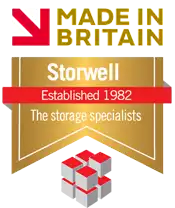
Here’s a brief description of each of the most common lock types used to secure the doors to gain or restrict access:

Hasp & Staple
A simple yet effective locking mechanism consisting of a hinged hasp that secures over a staple mounted on the door or gate. A padlock is then used to secure the hasp in place.
- Pros: Simple, affordable, flexible, easy to install.
- Cons: Low security, vulnerable to tampering, wears out in harsh conditions.
- Best for Low-security areas or budget-conscious installations.
Use: Commonly used for securing gates, sheds, and storage units, providing a basic level of security with easy installation and operation.
Standard Sash Lock (3 Lever)
A traditional locking mechanism featuring a mortise lock with three levers. This design provides a moderate level of security, as the levers must be lifted to the correct height to disengage the bolt.
- Pros: Moderate security, robust for metal doors, easy to install.
- Cons: Vulnerable to picking, requires key access, not ideal for high traffic.
- Best for Moderate security where traditional keys are preferred.
Use: Often used in residential doors, offering a balance of security and ease of use for everyday access.


Euro Cylinder Sash Lock with Thumb Turn
A modern locking system that uses a Euro cylinder for the lock mechanism. The thumb turn allows for easy locking and unlocking from the inside without a key.
- Pros: Convenient keyless entry from inside, better security than basic locks, replaceable cylinder.
- Cons: Vulnerable to picking, snapping, or bumping, may be overkill for light-duty storage.
- Best for Higher-security commercial or high-traffic environments.
Use: Ideal for residential and commercial doors, combining convenience with the option for key access from the outside, enhancing security.
Mechanical Digital Lock
A keyless locking system that uses a numeric keypad for entry. Users input a code to unlock the door, eliminating the need for physical keys.
- Pros: Keyless, easy to change codes, good for high-traffic areas.
- Cons: Code-sharing risks, wear over time, vulnerable to tampering.
Use: Often used in residential doors, offering a balance of security and ease of use for everyday access.


Emergency Panic Exit – Forward Push Bar or Push Pad or Break Glass Bolt
- Pros: Fast exit in emergencies, easy to use.
- Cons: It is not suitable for regular security; it is only for emergency exits.
- Best for Emergency exits or safety compliance, not for everyday storage security.
Use: Common in public buildings, schools, and commercial spaces, these locks enhance safety by providing unobstructed escape routes during emergencies.
Best Choices:
- Hasp & Staple for budget-friendly security.
- Euro Cylinder Sash Lock for higher security and ease of access.
- Mechanical Digital Lock for secure, keyless access in busy areas.
Each lock type serves a specific purpose, addressing varying security needs and access requirements in different environments.

How Storwell Systems Can Help You !
With over 40 years of experience, Storwell Systems provides custom steel partitioning solutions tailored to your business needs. Our high-quality, durable products are designed to optimize your space for maximum productivity and security. Our expert team will guide you through the entire process, from design to installation.
Why Choose Storwell Systems ?
- Custom Solutions: Tailored partitioning systems that meet your specific business requirements.
- Expert Guidance: A team of experienced professionals to assist you at every step of the design and installation process.
- Durable Products: High-quality steel partitions that require minimal maintenance and offer long-term durability.
- Quick Installation: Modular designs for efficient installation with minimal downtime.
Ready to Transform Your Space ?
Contact Storwell Systems today for a free consultation!
Get Free Expert Advice !
Complete the short form and we’ll get straight back to you.


